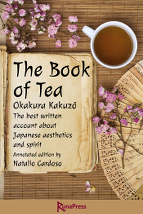
ISBN: 978-1520903255 |
The Book of TeaOkakura Kakuzō (annotated edition by Natalio Cardoso) “The Book of Tea” (1906), by Okakura Kakuzō, is the best written account about the Japanese spirit, the importance of its aesthetic perception and its relation with Taoism. Now it has been annotated by the expert in Japanese culture Natalio Cardoso. “The Book of Tea” is not a treatise about the tea ceremony, but an attempt to transmit to the Western reader the way in which the Japanese aesthetic sense works, which is, in their culture, closely linked to the soul of a whole civilisation. Okakura’s intention in writing in English this brief though important treatise about Japanese aesthetics and, ultimately, eastern philosophy was to open the eyes of the western world to the deep oriental spirit, which he considered unknown by Europeans and Americans. This lack of knowledge, for Okakura, did not have its roots in geographical distance, but in the lack of interest of the westerners and the desire of some Japanese of adopting the superficial foreign customs. In any case, our civilisation has opened itself to tea consumption and culture, and therefore to the East and its historic and philosophical riches. Oriental philosophy is always present in this work, because, as Natalio states in his introduction, “The Book of Tea is actually a synthesis of Taoism, Zen and teaism. As teaism has Taoist origins, it gives rise in Japanese culture to its supreme expression, the tea ceremony.” #east #japan #china #philosophy #taoism #aesthetics Buy book in:
Buy ebook in:
Contents of “The Book of Tea”
Prologue to this edition About “The Book of Tea”On occasion, Okakura's The Book of Tea has been given the subtitle “The Japanese Tea Ceremony”. Actually, The Book of Tea is not a treatise about the tea ceremony, as such a subtitle would denote, but an attempt to transmit to the Western reader the way in which the Japanese aesthetic sense works, which is, in their culture, closely linked to the soul of a whole civilisation. It is the Japanese soul that we want to comprehend when we approach any work by Okakura, with the tea ceremony simply acting as a vehicle to take us there, and indeed, a very well chosen vehicle, since the tea ceremony, particularly the Japanese one, is a combination of aesthetics, spirituality and communion. The cha-do (“the way of tea”) is what Okakura wants to make us understand with his word teaism. This art, or way of tea, finds its cultural expression in the tea ceremony or cha-no-yu (“hot water for the tea”). In Japan, art or aesthetics and philosophy are joined inseparably, in a way difficult to understand for a Westerner. We expect the reading of The Book of Tea to ease this task, since nobody is better than master Okakura, knowledgeable in both Eastern and Western views, in transmitting an idea as removed as this one from our European pragmatism. Chapter V, "Art Appreciation", will be particularly helpful; in it, the master rejoices in the humanity of the artwork, and thus its author, in communion with our own humanity. We will thus understand that the spectator is as necessary as the work itself for the art to exist, in the same way as the harpist is as essential as the harp for the miracle of music to take place. It has never been so true that beauty is in the eye of the beholder as in Japanese aesthetics, a union of art, philosophy and empty spaces. That is why The Book of Tea is actually a synthesis of Taoism, Zen and teaism. As teaism has Taoist origins, it gives rise in Japanese culture to its supreme expression, the tea ceremony. This ceremony is practised to promote harmony in humanity and with nature, to discipline the mind, soothe the heart and reach the pureness of illumination. It is a meditation; both the host and the guests are focused on the ceremony, on the tea and on the associated rituals. The Japanese have a good way to express it with the concepts of sabi and wabi. Sabi (寂) represents exterior imperfections, those given by life (not only to us but also to material things), such as wrinkles that appear in our face after decades of tears and laughter, and which are a part of ourselves. It is the original nature of things. Wabi (侘) is the interior, the spiritual experiences, but it also means simplicity and quietness. All this, and much more, constitutes the tea ceremony; this gives form to teaism, which is a manifestation of the Japanese aesthetic philosophy; and it is this philosophy that master Okakura aims to transmit in The Book of Tea. Buy book in:
Buy ebook in:
|
Runa Press
Company |
Contact
Runa Press — Tarsis.net SL |
ShareFind us: |